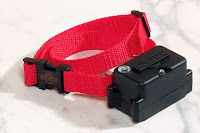 Dog training equipment is usually employed to help dog and owner to live together in a happy environment. There are many types of equipment available each with its own set of advantages and disadvantages. Owners will have to decide either on their own or through the advice of professionals on what type of equipment will work best for the specific animal.
Dog training equipment is usually employed to help dog and owner to live together in a happy environment. There are many types of equipment available each with its own set of advantages and disadvantages. Owners will have to decide either on their own or through the advice of professionals on what type of equipment will work best for the specific animal.The electronic fence uses a wire that runs along the area containing the dog. The wire is usually attached to an existing fence which projects a radio signal, an electronic receiver is placed on the collar of the dog and if he tries to go outside the boundaries of the fence the dog receives a small static shock which makes him withdraw from the boundary area.
The fence is a great way of training the animal to stay away from certain areas of the yard or to keep the dog from straying onto other people’s property. There are also variations to the fencing option, such as a ‘split rail’ fence which provides a strong base to which fabric must be added inside the fence in order to keep the dog confined, There is also ‘chain link' which is one of the most common types of dog fence: it is a series of small diamond shaped heavy gauge wire segments. This option is usually used at professional kennels.
Other options include the snow fence, farm fence, hybrid fencing and hidden or invisible fencing. There are many advantages to using these fencing options because you can allow your pet the ability to roam free without having to worry about them running into oncoming traffic or the neighbor’s yard. It is also better than having to tie the animal when you are not home, or keeping them enclosed in a room. The fence allows for larger boundaries, but the cost can be an added factor that ranges according to the type of fence - however, less expensive options can cost less than $200.
Although there are advantages to using this method of dog training, more accurately termed dog conditioning and containment,there are also some consequences involved. The first is that depending on its height and construction, the fence may be a one way constrictor system, meaning that although the dog cannot go out, intruders, kids or other animals can possibly get inside the barrier. Another disadvantage is that the dog has to be trained to identify the proximity of the transmitter and the shock which can be very time consuming. Many people argue that these electric dog fences are inhumane.
The invisible dog fence also has its own disadvantages. Neighbors or other passers-by may not realize that the dog is contained and call animal control due to fear. Also many times the collar that works with the fence may cause sores or burns on the animal - these can become infected which can ultimately harm the animal if not recognized early. Another thing to consider is that this option may not work on all dogs, some may choose to simply ignore the shock associated with it and run out of the boundary to chase animals or passers-by, they may also run into oncoming traffic and get hurt.
